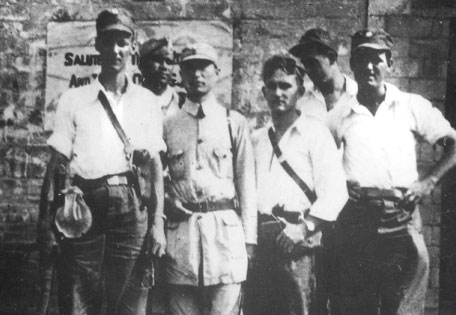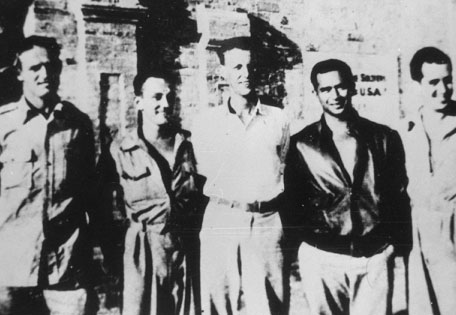Flying tigers a symbol of friendship, then and now
By Joseph Catanzaro, Li Yang,Huang Zhiling and An Baijie (China Daily) Updated: 2015-06-26 07:45
|
Chinese soldiers assist US pilots with their parachutes after they bailed out of their plane and touched down near Hongze Lake, in Jiangsu province, in August 1944. |
Wartime alliance
Rana Mitter, director of the University of Oxford's China Centre and author of Forgotten Ally: China's World War II, 1937-45, is among the historians working to broaden the historical narrative.
During the Cold War, Western nations and China all forgot the significance of their wartime alliance against Japan, he said. "Various things China did changed the path of the war. Most noticeably, the decision to continue resistance after (Japan invaded in) 1937, when they could well have surrendered. Over the course of the war, at their height, (China) were holding down (about) 500,000 Japanese on the Chinese mainland."
Those Japanese troops could not be deployed in Southeast Asia or the Pacific theater, a handicap that may have changed the outcome of key battles and saved the lives of many US servicemen. Mitter said Japan planned to conquer China in three months, yet almost five years after its initial invasion, when Pearl Harbor was bombed and China formally became one of the Allies, Japan was still "stuck in the Chinese quagmire".
China paid a heavy price for its refusal to surrender. By the time the guns fell silent in 1945, an estimated 35 million Chinese soldiers and civilians had been killed or wounded.
"Without the Chinese contribution, it's much harder to see an Allied victory in Asia during the war," Mitter said. "But without the British and Americans, it's also much harder to see a Chinese victory."
Nell Calloway, director of the Chennault Aviation and Military Museum in Louisiana, has just launched an exhibition on the extraordinary achievements of the Flying Tigers commander. Similar to Vice-Premier Liu, a woman she has met with several times, Calloway has a personal connection with the Flying Tigers: She is Chennault's granddaughter. The 65-year-old said her grandfather's dream was that the squadron would "always be remembered on both sides of the Pacific as the symbol of two great peoples working toward a common goal in war and peace".
She said greater knowledge about the wartime US-China alliance could help lead to lasting peace and friendship in the future.
It's a message close to Long's heart. When he speaks about the Flying Tigers, there is still something in his voice of that boy who looked up and saw salvation. And in Hayward, there is still a glimmer of that young bomber pilot looking back down.
"We continually asked ourselves when we were over there, 'Are we really doing any good for anybody?' I'm really pleased we were able to do something useful to help people like that young boy," Hayward said. "I certainly advocate lasting peace between our countries."
Cheng Yilun contributed to this story.
Contact the writers at josephcatanzaro@chinadaily.com.cn
|
Zhang Aiping (third from left), of China's New Fourth Army, poses for a picture with five US pilots who were rescued by a squad of Chinese soldiers. |
|
The rescued pilots appear in a more relaxed mood, also in 1944. Provided to China Daily |
- Govt encourages people to work 4.5 days a week
- Action to be taken as HIV cases among students rise
- Debate grows over reproductive rights
- Country's first bishop ordained in 3 years
- China builds Tibetan Buddhism academy in Chengdu
- Authorities require reporting of HIV infections at schools
- Typhoon Soudelor kills 14 in East China
- Police crack down on overseas gambling site
- Debate over death penalty for child traffickers goes on
- Beijing to tighten mail security for war anniversary










